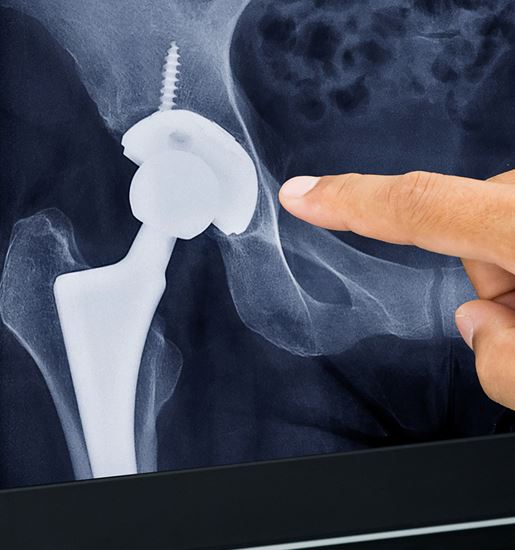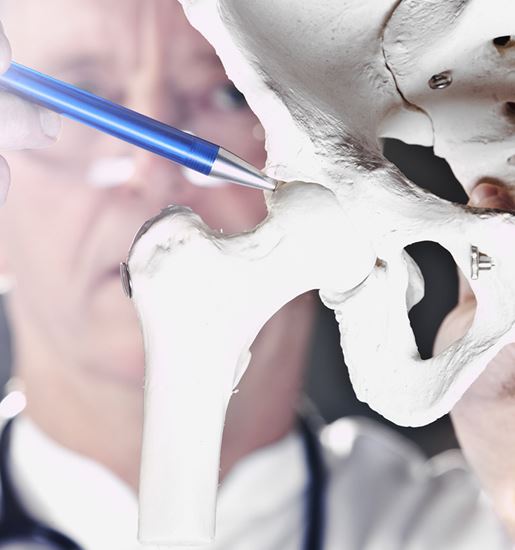Hip Replacement Surgery in Melbourne
- Home
- Services
- Orthopaedics
- Hip Orthopaedics
- Hip Replacement
- Hip Replacement Surgery in Melbourne
Hip replacement surgery in Melbourne
Hip replacement surgery is widely available in Melbourne with the option of four outstanding St Vincent Private Hospitals on offer. Whether it’s East Melbourne, Kew, Fitzroy or Werribee, each hospital offers state-of-the-art operating facilities, alongside a highly experienced team of clinical specialists all dedicated to your care and recovery. Leading the way with the latest in technological innovations, our world-class surgeons are committed to delivering medical excellence in the Melbourne area and improving the patient experience at every stage.
Total hip replacement surgery
Total hip replacement surgery is considered one of the most successful in modern medicine and with numerous St Vincent’s orthopaedic surgeons operating in Melbourne alone, it is now one of the most performed surgeries across Australia. The hip is one of the body’s largest weight-bearing joints and works just like a ball and socket. Over time it can become vulnerable to injury or disease such as osteoarthritis and as we age, the protective cartilage around our hip joint gradually wears away leaving the bones exposed. When the bones rub up against each other it causes intense pain, swelling, stiffness and discomfort. Living with arthritic hip pain can severely impact your quality of life and interfere with your normal daily activities. Hip replacement surgery is a highly effective way to significantly reduce recurrent hip pain, as well as restore mobility and function. This procedure can be performed at all ages.

- Jump to:
- Hip replacement recovery
The procedure
Hip replacement surgery uses advanced surgical techniques to repair the hip joint by replacing any damaged parts with artificial implants. During surgery, the ball-shaped femoral head is removed and replaced with an artificial ball and stem. This is usually made of metal or ceramic. The damaged surface of the socket is removed and replaced with a ceramic or plastic spacer, and the joint is tested for stability and flexibility. Physical balance is also checked to prevent problems with unequal leg length. The operation itself usually takes around 2-3 hours, with 3-4 days spent recovering in hospital. Patients are encouraged to move around soon after surgery as this is known to aid the recovery process. Certain patients may be eligible for an accelerated recovery program with a return to most activities within 12 weeks. A full recovery can take up to one year.

Surgical approaches
The Melbourne Orthopaedic team are highly experienced in joint replacement procedures and were amongst the first hospitals to adopt the minimally invasive robotic-assisted surgical techniques as a treatment option. The two most commonly used approaches for hip surgery are the posterior approach (where the joint is accessed through the back of the femur) and the direct anterior approach (where the joint is accessed from the front). Anterior hip replacement is gaining in popularity as there is less damage caused to the muscles, and this can mean a quicker recovery in the initial stages.
However, there is no research to suggest one approach is better than the other in the long term and your hip surgeon will discuss with you individually, which procedure will achieve the most optimum results. Some patients may be eligible for minimally invasive hip surgery, which uses smaller incisions. This type of surgery can reduce pain and speed recovery, but it is not always appropriate for all patients. There are many factors to help your doctor determine if you are a suitable candidate including age, weight and general health.
Other types of hip replacement surgery
There are a number of conditions that can cause hip pain and your doctor will perform a series of tests to identify the cause of the problem. From here you can discuss possible treatment options that may include:
Total hip replacement surgery is a comprehensive approach to addressing hip joint injuries or diseases involving both parts of the joint. In contrast, a partial hip replacement is suitable for individuals who have sustained an injury specifically to the ball-shaped femoral head of the thigh bone (femur), while the socket area of the hip remains unaffected. This surgical procedure involves the removal of the damaged femoral ball and its replacement with an artificial component. It is commonly employed to treat hip fractures but is generally not recommended for managing hip arthritis.
One of the advantages of partial hip replacement is its potential for a minimally invasive approach. This means the surgery requires less time, results in reduced postoperative pain, and leads to a quicker recovery period compared to traditional methods.

As time passes, certain artificial components used in hip replacement surgeries may experience issues such as loosening, infection, or natural wear and tear. If you start experiencing familiar aches and pains, it could be a sign that you may need revision hip surgery, especially if your initial hip surgery was conducted around 15-20 years ago.
Revision hip surgery typically presents a lengthier and more intricate procedure compared to the primary hip replacement. This complexity arises mainly because the implants may still be firmly attached to the bone. The extent of replacements needed will determine the intricacy of the revision surgery.
Bilateral hip surgery, also referred to as double hip replacement, involves a total hip replacement procedure performed on both sides of the body. This surgery can be done in two ways: either simultaneously, addressing both hips at once, or as a staged procedure with a time gap between surgeries.
The simultaneous approach to a bilateral hip replacement offers the advantage of having only one operation, one anaesthesia, and one recovery period. However, it comes with added risks due to the longer duration of the surgery, potentially leading to an extended hospital stay and a more prolonged recovery period.
However, the staged procedure involves a gap of approximately three months between surgeries. This approach allows for a more manageable recovery from each surgery individually, reducing the potential risks associated with a longer simultaneous operation.


Can Medicare help with my hip surgery in Melbourne?
The cost of your surgery is dependent on a number of factors that will vary by patient, including your level of private health insurance and the cost of your surgical team in Melbourne, which can differ between hospitals. Find out more about your Medicare rebate here.
What else should I consider?
Going into hospital can be a stressful experience, but here in Melbourne, we work as one team to ensure the highest levels of medical and therapeutic expertise. Your wellbeing and recovery are always at the heart of our patient-centred care.
Find out more by booking a specialist consultation today.

Related services

Total Hip Replacement
This surgery replaces the damaged parts of your hip with artificial materials.
Read More
Orthopaedics at St Vincent’s Private Hospital East Melbourne
St Vincent’s Private Hospital East Melbourne
Read More
Orthopaedics at St Vincent’s Private Hospital Fitzroy
An extensive range of orthopaedic services and the very best in surgical expertise.
Read More